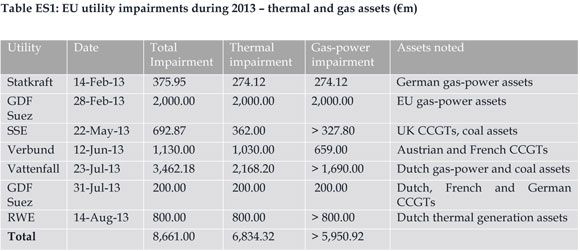Ten of Europe’s largest utilities planned to mothball or close more than 20 gigawatts of combined-cycle gas turbine power plants from 2012 to 2013.
Nearly half of the capacity, 8.8 gigawatts, was built or acquired in the past decade, according to a recent study from Oxford University. Overall, 110 gigawatts of installed CCGT capacity, 60 percent of the European Union’s total gas-fired capacity, is not recovering fixed costs and could close in the next three years. Some energy companies are even considering dismantling CCGT plants and moving them to more profitable markets.

The closures are due to many factors, starting with depressed wholesale electricity prices from the recession. But that was just the beginning. Increased renewable capacity due to decarbonization policy was also a major factor, as it curtailed expected running hours for thermal power plants and further depressed wholesale prices.
The confluence of lower demand, lower prices and more renewables was compounded by the fact that coal prices decreased by about one-third since 2011, according to the study.
“As gas prices remain high, it is unlikely that EU gas-fired power plants will regain competitiveness against coal power on the basis of fuel price changes alone,” lead author Ben Caldecott, program director for the Stranded Assets Program at Oxford’s Smith School of Enterprise and the Environment, wrote in the study.
Another study from Oxford about the prospect of gas capacity in Germany noted that its carbon price is far too low to encourage fuel switching from coal to gas.
The U.K. will introduce a technology-neutral capacity market this year that will start delivering capacity for the 2018-2019 season, as well as a proposed supplemental balancing reserve. Utilities are, unsurprisingly, supportive of the move, but some question the ability of the new capacity market to address constraints in the next few years, according to the study. Germany is also looking to implement a capacity market in the medium term and has called for a one-year moratorium for plants that are “system-relevant.”

But the study authors warn that capacity markets could be only complicate matters further. “Capacity mechanisms that only reward long-term adequacy may not incentivize the flexibility characteristics of generation (storage, etc.), which will be valued in the future, both in terms of ramp-up speed and maintenance costs,” they note in the study.
“Beyond flexibility issues, unintentional interactions between [capacity restructuring mechanisms], stranded assets and decarbonization objectives -- including policies to incentivize low-carbon investment -- could have conflicting effects on policy effectiveness.”
The Oxford study released in March about the German outlook for gas-fired power plants argues that gas assets can more easily be future-proofed to operate in a low-carbon economy than can coal-fired power plants. In some cases, CCGT, which can often respond faster than coal-fired assets, could earn some money in the ancillary services market. But it faces competition there too, especially from increasing demand response in countries with high renewables penetration and the falling cost of batteries, which can also provide those grid services.
The reality of stranded assets is forcing some large generating utilities to rethink not just gas investments, but also business models. Last fall, RWE, one of Europe’s largest utilities, penned a plan to transform itself from a traditional electricity provider to a renewable energy services provider.
In the U.S., where the outlook for gas-fired power plants is significantly different, some utilities are rethinking the future of generation. NRG Energy’s CEO David Crane recently issued a manifesto about the need to shift his business to a consumer-focused company, even as it sits on about 53,000 megawatts of generation, most of which is oil, coal and natural gas.



